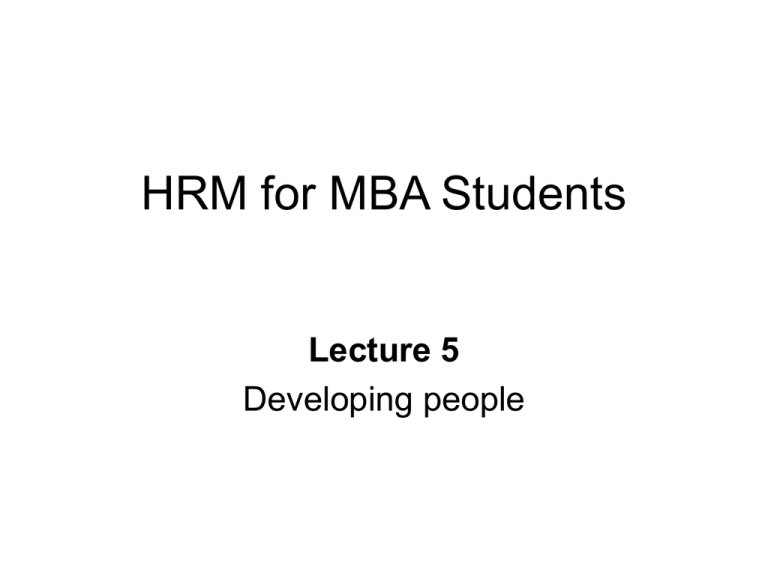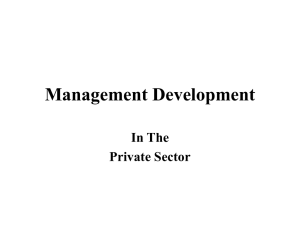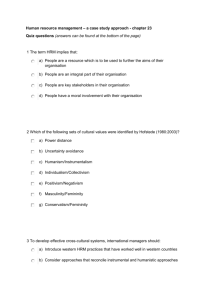Some Common Learning and Development Methods Action
advertisement

HRM for MBA Students Lecture 5 Developing people Learning outcomes • Understanding the definitions of training and learning • Knowing how to undertake a training needs analysis and its purpose • An appreciation of the necessity to identify learning objectives • Understanding the importance of learning theory and the principles of learning • An appreciation of the main learning and development methods used in organisations • Understanding the Kirkpatrick model of training evaluation • Understanding the concepts of single- and double-loop learning • Knowing what is meant by the term ‘learning organisation’ Training • is defined as: – a set of planned activities on the part of an organisation to increase job knowledge and skills, or to modify attitudes and social behaviour, to achieve specific ends which are related to a particular job or role. Learning • is defined as: – a relatively permanent change in knowledge, skills, attitudes or behaviour that comes through experience. Learning happens inside the person whereas training is something that is given to a person: it is a planned experience that is expected to lead to learning. Learning interventions under PM and HRM People-management paradigm Class of employee Nature of learning intervention/ activity Formal, external Non-managerial employees PM HRM Managers and other professional All (core) employees Formal in-house Educational courses Off-the-job (usually vocational in training nature) Informal inhouse On the job training Self development [ignored] [ignored ] Development Learning and Development Learning interventions and activities in HRM Type Nature Formal Informal Externally provided accredited education, eg: MBAs; NVQs; Professional qualifications Voluntary accredited education Externally provided training courses Voluntary attended training course Learning partnerships Coaching Mentoring Peer relationships Action learning Self-development Self-development groups Learning logs Off-the-job On-the-job Key learning principles • The principle of ‘distributed practice’ – ie breaking the learning experience up into manageable chunks for the learner • Reinforcing the learning by praising the learner for correct responses • Training individuals to perform entire task units as a whole • Giving results of the training performance to the learners • Providing opportunities for practising the skills developed during training Kolb’s learning cycle 1 Concrete experience 2 Observations and reflection 3 Formation of abstract concepts and generalisations 4 Testing the implications of the concepts in new situations The learning experience runs in sequence from 1 through to 4 Learning styles and the Kolb cycle • ‘Activists’ tend to learn best from the experience stage: they prefer to take action – eg hands-on learning or role-playing • ‘Reflectors’ tend to learn most from the second stage – observation and reflection • For ‘Theorists’ learning is most effective at the third, abstract conceptualisation stage • ‘Pragmatists’ learn best from trying out the new skill or knowledge in actual work situations, so they benefit most from the fourth stage of the Kolb cycle Transfer of learning To increase the probability of learning transfer: • maximise the similarity between the learning situation and the job situation • provide as much experience as possible with the task being taught • provide for a variety of examples when teaching concepts or skills • label or identify important features of a task • make sure the general principles are understood • make sure that the learned behaviours and ideas are rewarded in the job situation • design the learning content so that the learners can see its applicability Some Common Learning and Development Methods • Action Learning: – originally introduced for management development but now widely used at all organisational levels. – groups of people work together to find practical solutions to real work problems. – Instructors act as facilitators, • Blended learning: – a combination of multiple approaches to learning. – typically a combination of technology-based materials and face-to-face sessions Some common learning and development methods • Case studies – detailed examinations of real-life situations written up and presented for educational purposes – students typically work in groups to analyse each case and answer set tasks • Coaching – a non-directive form of development, which focuses on improving performance and developing individuals’ skills and giving feedback on a person’s performance – should be delivered by trained personnel, who are usually drawn from outside the organisation Some common learning and development methods (cont.) • Continuing Professional Development (CPD) – a continuous process of personal growth, to improve the capability of people at work and realise their full potential – achieved by developing a range of knowledge, skills and experience which go beyond initial training or qualification, and which maintain and develop professional competence – many professional bodies such as the CIPD now insist on CPD as a condition of continued membership Some common learning and development methods (cont.) • Corporate universities – more than just in-company training departments, they have been defined as: [a] centralised strategic umbrella for the education and development of employees ... [that] is the chief vehicle for disseminating an organisation’s culture and fostering the development of not only job skills but also such core workplace skills as learning-tolearn, leadership, creative thinking and problemsolving. Meister (1998) Some common learning and development methods (cont.) • E-learning – learning that is delivered, enabled or mediated using electronic technology for the explicit purpose of learning and development in organisations • Instruction – a highly structured teaching method used to teach specific skills – the format typically comprises a physical demonstration followed by supervised practice of the skills concerned Some common learning and development methods (cont.) • Lecture – a structured talk, longer and more formal than a presentation, normally accompanied by visual aids and handouts of key points – may be combined with audience participation in discussion, a question-and-answer session and/or group exercises/activities • Mentoring – similar to coaching although the mentor is usually an experienced senior member of staff, but not the person’s line manager – the emphasis in mentoring is less focused on the person’s current job or role than in coaching, but more on their future development and career within the organisation Some common learning and development methods (cont.) • Outdoor training – team exercises involving physical and mental tasks in challenging external environments – very popular in corporate team-building – believed by advocates to teach leadership and teamand self-development skills in addition to teamworking • Role-playing – the enactment of roles in a structured context – very useful in practising inter-personal skills Some common learning and development methods (cont.) • Self-development – is concerned with helping people to understand their own personal learning and development processes and by doing so to assume greater control of, and responsibility for, their own development – an emphasis on longer-term development as distinct from specific study or learning – a stress on setting one’s own goals and methods for achieving development – this approach can be applied to groups where participants are encouraged to support each other – self-development is frequently, but not exclusively, applied to managers and professionals Some common learning and development methods (cont.) • Simulations/business games – group exercises or case studies, usually computerised, in which the students are asked to make certain choices and then deal with consequences of their decisions – usually run in competitive syndicates of students Formal learning interventions • A four-stage process: 1 2 3 4 • Identifying the development need Designing the development activity Undertaking the development activity Evaluating the development intervention This process is sometimes called the ‘training cycle’ Needs analysis • provides a set of learning objectives for the development programme – these objectives might include adding knowledge, developing specific skills or helping to form specific attitudes – eg towards customers or clients The learning objectives – guide us as to what learning principles and training methods should be used. – secondly, provide a means for assessing afterwards whether the learning intervention has been successful Evaluating a learning intervention • Kirkpatrick’s model: a four-stage process – – – – Trainee reactions Learning reactions Learning behaviour/behavioural change Results/performance Informal learning • The learning an individual acquires: – from the experiences of doing the job – from working in the organisation – from thinking and reflecting on the work • The US Bureau of Labor (1996) found that people learned 70% of what they know about their jobs informally through processes that were not structured or sponsored by their employing organisation A learning organisation An organisation which facilitates the learning of all of its members and [thereby] continuously transforms itself. (Pedler, Boydell and Burgoyne) Tacit and explicit knowledge • Tacit knowledge: – personal, context-specific, and therefore hard to formalise and communicate • Explicit knowledge: – can be transmitted in formal, systematic language (eg written down) We can know more than we can tell Polanyi (1966, p.4) Management development The entire structured process by which managers learn and improve their skills for their employing organisations. CIPD Factsheet on Management Development (February, 2007) Most common formal methods for management development • external courses • seminars and conferences • in-company training to develop individual skills • in-company training to develop organisational skills • pursuing external formal qualifications (such as MBAs) Most common informal methods for management development • • • • • in-company job rotation job observation on-the-job training mentoring coaching Conditions for successful management development • It is recognised by the organisation as a strategic business activity • Management development programmes recognise the nature of managerial work • Programmes are tailored to fit the needs of the individual managers on them • Education, training, selection, career planning, reward systems and managerial evaluation are recognised as all being part of a connected system • Evaluation is itself a vital part of the system of development








